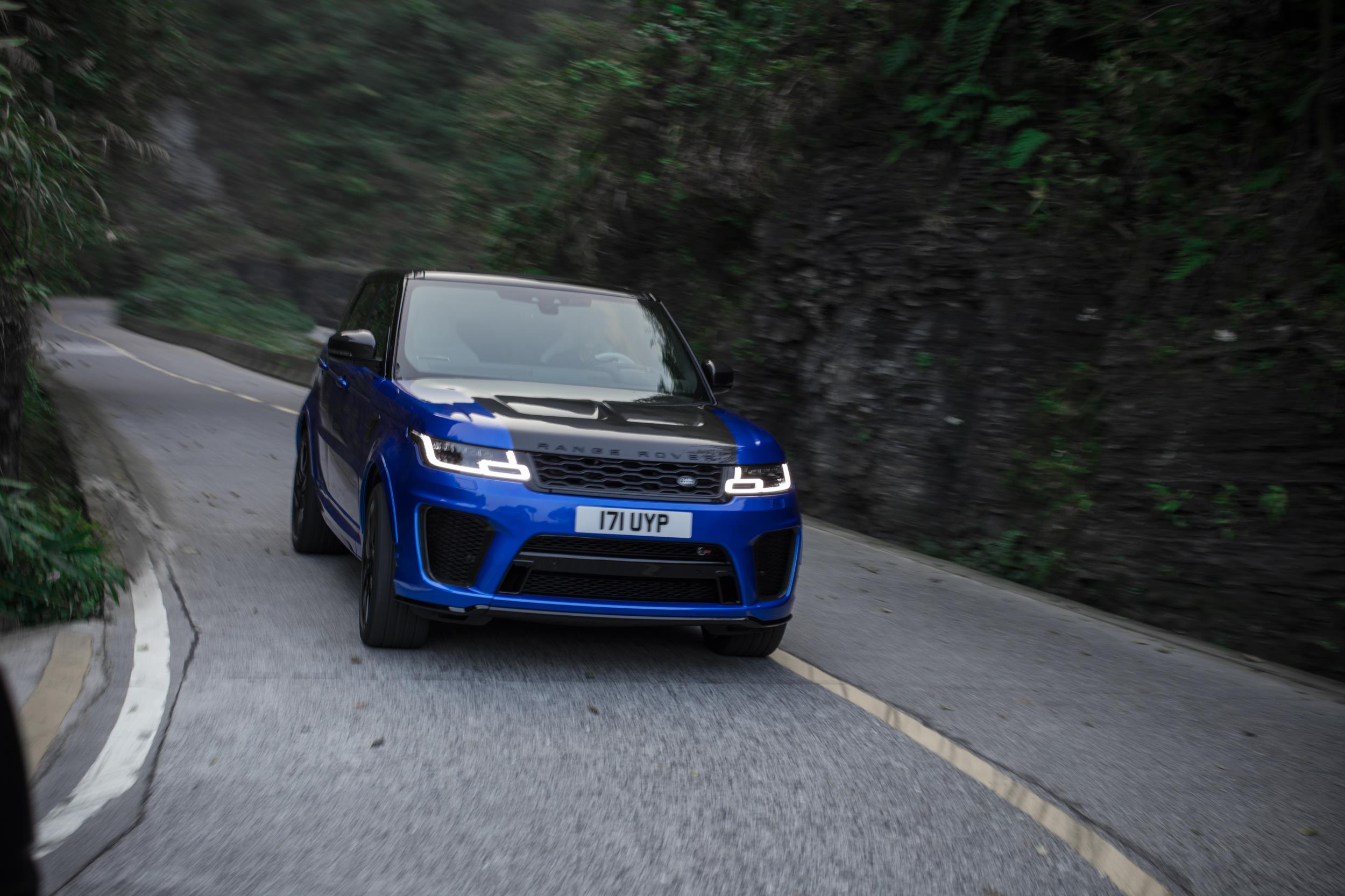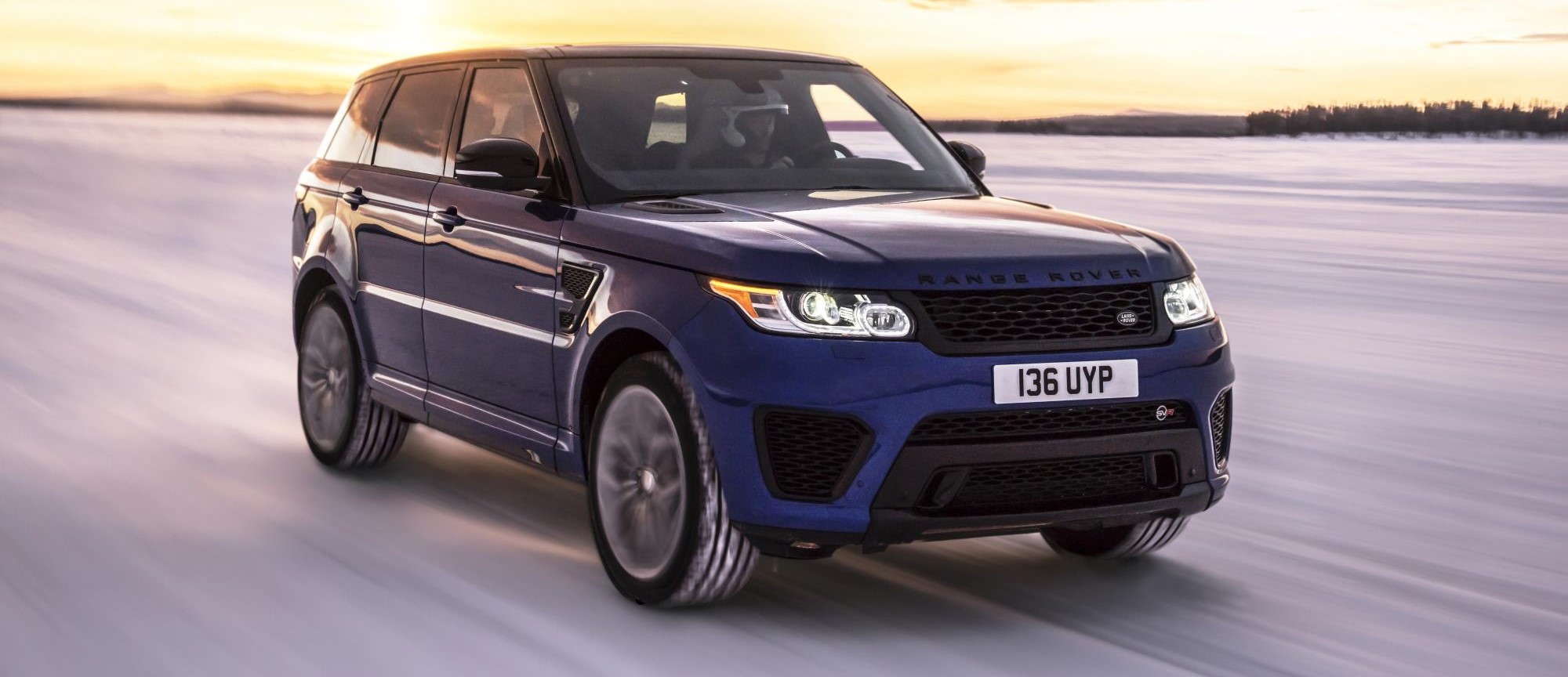- New performance SUV beats supercar record for tackling the 99 turns of the world-famous Tianmen Road in China
- 575PS Range Rover Sport SVR features enhanced V8 supercharged engine, delivering 0-100km/h in 4.5 seconds (0-60mph in 4.3 seconds)
- Performance flagship completed epic drive in 9 minutes 51 seconds, beating benchmark of 10 minutes 31 seconds set by a Ferrari 458 Italia
- Standard production SVR model was piloted by Le Mans class-winner and Panasonic Jaguar Racing reserve and test driver Ho-Pin Tung
Hunan Province, China, 13 March 2018 – An SUV is not meant to outperform a supercar, but that’s exactly what happened when the new Range Rover Sport SVR took on a fearsome mountain road in China.
Land Rover’s performance SUV, driven by Panasonic Jaguar Racing driver Ho-Pin Tung, has smashed the record for negotiating the 99 corners of the famous Tianmen Road.
The standard production Range Rover Sport SVR set a new unofficial record of 9 minutes 51 seconds for the 11.3km ascent at an average speed of 68.8km/h (42.8mph), beating the previous best of 10 minutes 31 seconds – set by a Ferrari 458 Italia supercar in 2016.
With 575PS available from its enhanced V8 supercharged engine, the new Range Rover Sport SVR is the fastest ever Land Rover and can accelerate from 0-100km/h in 4.5 seconds (0-60mph in only 4.3 seconds) with a top speed of 280km/h (174mph). The new performance flagship features bold design revisions and increased use of lightweight materials to enhance performance, handling and agility.
Coupled with changes to the chassis, the new SVR delivers more dynamic responses without compromising traditional Range Rover comfort. The engineers at SVO focused on controlling pitch under heavy acceleration and braking, and changes to the damping hardware have improved turn-in, mid-corner grip and body control.
Panasonic Jaguar Racing’s Ho-Pin Tung said: “I am used to the high speeds of racing but this was even more demanding. Maintaining concentration was the biggest challenge as the road twists and turns constantly, with huge drop-offs to the side. The consequences of getting it wrong would have been really serious so I focused on establishing a rhythm and the Range Rover Sport SVR made this easy – it may be an SUV but it has the performance and agility of a supercar and can take you to places a supercar can only dream of.”
The optional exposed carbon fibre bonnet is one of the distinctive innovations introduced by the experts at Special Vehicle Operations and features a pair of large air vents to underline its performance potential. A revised front bumper provides enhanced brake and engine cooling while the 5.0-litre V8 supercharged engine produces 700Nm of torque.
Inside, new lightweight SVR Performance seats provide superior support and traditional Range Rover luxury with Windsor leather, an embossed SVR logo and a choice of four colour combinations.
The record-breaking ascent is the latest challenge completed by the Range Rover Sport after the PHEV model made the dizzying climb to the iconic Heaven’s Gate natural rock arch at the road’s summit last month. The PHEV made its debut in a race against two-time open-water swimming world champion Keri-anne Payne and endurance athlete Ross Edgley in Devon, UK.
The Range Rover Sport SVR is priced from £99,680.
2018


2016

RANGE ROVER SPORT SVR ALL-TERRAIN ACCELERATION TESTS
- All-terrain acceleration tests conducted at six venues across Europe prove Land Rover capability and pace on different surfaces
- Every sprint completed on OE 21-Inch Michelin All-Season Tires
- Land Rover Terrain Response® 2 technology optimizes acceleration on grass, gravel, snow and sand2
(MAHWAH, N.J.) – January 22, 2016 – In a unique testing exercise, Jaguar Land Rover Special Vehicle Operations (SVO) put the Range Rover Sport SVR through its paces completing a series of 0-100kph sprints on a variety of surfaces including asphalt, grass, snow and sand.
Using Michelin 275/45 R21 All-Season tires and the Land Rover Terrain Response® 2 system – both of which are standard for the Ranger Rover Sport SVR – the test aimed to highlight the real world performance and inherent capability of the super-SUV in the same trim as it leaves the factory.
As part of this ultimate all-terrain performance test, the Range Rover Sport SVR was taken to six venues across Europe, each offering challenging terrain for the vehicle to tackle using its Terrain Response 2 system. When engaged, the intelligent system automatically selects the appropriate driving mode to suit traction conditions including: General Driving, Dynamic, Grass/Gravel/Snow, Mud and Ruts, Sand, and Rock Crawl. The driver can also use the rotary controller on the center console to choose a specific mode for the conditions ahead2.
Merging Land Rover’s well-known on- and off-road capabilities with a specially-tuned V8 producing 550 supercharged horsepower, Land Rover’s advanced traction technologies help deliver not only the brand’s quickest vehicle ever, but one with unique real-world performance.
Since arriving in showrooms in spring 2015, the Range Rover Sport SVR has showcased the abilities of Jaguar Land Rover Vehicle Operations and has contributed to more than 285,000 second-generation Range Rover Sport models being delivered to customers around the world. Many customers will have been attracted by the 0-100kph time of only 4.7 seconds1, but the official figure only scratches the surface of the dynamic range of the brand’s performance SUV.
The times recorded as part of these tests are a testament to the inherent capability of the Range Rover Sport SVR. On a notoriously slippery wet grass surface, acceleration times from tarmac increased by only 0.8 seconds, the same on sand too.
| Terrain | Mode | 0-100kph time1 |
| Asphalt | Dynamic | 4.7 seconds |
| Grass | Grass, Gravel and Snow | 5.5 seconds |
| Gravel | Grass, Gravel and Snow | 5.3 seconds |
| Snow | Grass, Gravel and Snow | 11.3 seconds |
| Mud | Mud and Ruts | 6.5 seconds |
| Sand | Sand | 5.5 seconds |
The first challenge ahead of the Range Rover Sport SVR was the start-finish straight at Europe’s fastest racing circuit, Rockingham Motor Speedway in Corby, UK. In Dynamic mode, Terrain Response 2 sharpens throttle response and changes gear at higher revs. It also stiffens the Continual Variable Damping function within the vehicle’s Anti-Roll Control technology to reduce body roll2. With all of these factors optimized, the Range Rover Sport SVR blasted from 0-100kph in just 4.7 seconds1.
In the second test, the high-performance SUV tackled one of the most challenging surfaces any driver will encounter: wet grass. In Grass/Gravel/Snow mode the throttle response is softened to prevent loss of traction and gear changes are smoother and quicker. The Traction Control System also intervenes earlier to prevent tire slip, while the central differential is preloaded to optimize off-the-line performance2. Land Rover Experience East of England provided the perfect setting for this challenge and the Range Rover Sport SVR recorded a breath-taking 0-100kph time of 5.5 seconds1.
In the third test, a quarry provided an ideal gravel surface, where the inherent traction of the Range Rover Sport SVR came to the fore. With the vehicle systems optimized to suit the loose surface, the Range Rover Sport SVR registered the sprint from naught to 100kph in 5.3 seconds1.
To find snow the Range Rover Sport SVR headed to the Jaguar Land Rover winter test facility in Arjeplog, Northern Sweden. Here, the optimized settings of Terrain Response 2 technology2, combined with the advanced four-wheel drive system in the Range Rover Sport SVR helped the SUV – on standard all-season tires – complete the sprint on a combination of snow and ice in 11.3 seconds1.
The next switch of the Terrain Response 2 dial was to select Mud and Ruts mode. In this setting the air suspension is raised and the Traction Control System allows controlled tire slip to provide better traction in slippery conditions2. In typically British surroundings at one of Land Rover’s all-terrain testing facilities, the performance SUV logged a 0-100kph time of 6.5 seconds1 as its intelligent four-wheel-drive technology came into its own.
Pendine Sands at Carmarthen Bay in South Wales has been linked with speed ever since hosting the first world land speed record run took place there in 1924. That made it perfect to test the next setting on the Terrain Response 2 dial: sand. Selecting Sand mode sharpens the vehicle’s accelerator responses to allow a quick build-up of engine torque. The vehicle also holds onto gears for longer and locks the central differential to help maintain momentum2. The result of this technological wizardry was a 0-100kph time of 5.5 seconds1.
The final mode on the Terrain Response 2 dial called for something different. Rock Crawl is designed to assist drivers when negotiating rocky environments and works in conjunction with the Low Range transmission, in keeping with the low-speed nature of the challenge posed by large rocks and boulders2.
Rock Crawl mode softens the accelerator response to mitigate against sudden movements and provide maximum driver control. It also raises the air suspension, to optimize ground clearance. Using Terrain Response 2 the Range Rover Sport SVR scaled the rocky 32 percent incline at the test facility with ease2.
Driver Darren Jones, Stability Applications Leader, Jaguar Land Rover, said: “The Range Rover Sport SVR is famed for its on-road performance, but this hasn’t been achieved at the expense of customary Land Rover capability.”
Notes:
Venue 1:Rockingham Race Circuit – Dynamic – 4.7 seconds
Venue 2: Land Rover Experience Centre, East of England – Grass – 5.5 seconds
Venue 3: Quarry, South Wales – Gravel – 5.3 seconds
Venue 4: Winter Testing Facility, Arjeplog, Sweden – Snow – 11.3 seconds
Venue 5: All-Terrain Testing Facility, South Wales – Mud – 6.5 seconds
Venue 6: Pendine Sands – Sand – 5.5 seconds
1 Allows follow local speed limits.
2 These systems are not a substitute for driving safely with due care and attention and will not function under all circumstances, speeds, weather and road conditions, etc. Driver should not assume that these systems will correct errors of judgment in driving. Please consult the owner’s manual or your local authorized Land Rover Retailer for more details.
